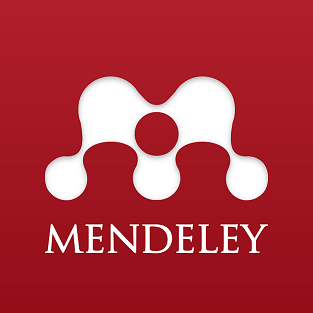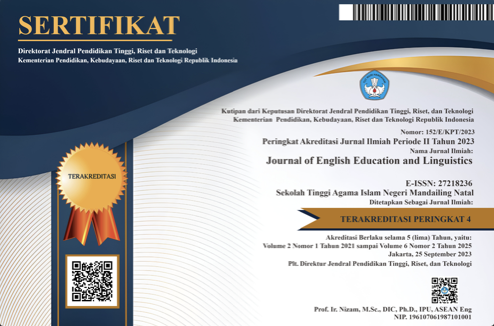“CTRL + C, CTRL + V”: ACADEMIC INTEGRITY IN ONLINE LANGUAGE LEARNING
DOI:
https://doi.org/10.56874/jeel.v4i2.1410Keywords:
Camarines Sur Polytechnic Colleges, Academic Integrity, Plagiarism, Turnitin, Online Language LearningAbstract
This qualitative study aims to explore academic integrity in terms of plagiarism issues in online language classes at Camarines Sur Polytechnic Colleges. The study has two research questions: (1) What types of plagiarism do online submitted outputs of students in online language classes fall? (2) What strategies do college instructors use to prevent and detect plagiarism in their language classes? Turnitin and content analysis were utilized to identify types of plagiarism committed by students, while structured interviews and thematic analysis were used to gather data on strategies used by college instructors. Results indicated that among the five types of plagiarism, Mosaic Plagiarism or Patch Writing was the most prevalent, while Structural Plagiarism had the least number of cases identified, and no instances of Self-Plagiarism were found. Nonetheless, some outputs were plagiarism-free. The study also identified language instructors' strategies to prevent and detect plagiarism in their classes. The study recommends that academic institutions prioritize creating a culture of honesty and ethical behavior in academic writing, educate students on clear citation guidelines, and implement stricter penalties. The study's results can assist policymakers and educational institutions create practical measures to encourage academic honesty and avoid plagiarism in online language classes.
References
Abel, J., Sima, R., & Shavega, T. (2020). The Intensity of Academic Dishonesty among Postgraduate Students in Higher Learning Institutions in Tanzania and How to Curb the Situation.https://www.idpublications.org/wp-content/uploads/2020/09/Full-Paper-THE-INTENSITY-OF-ACADEMIC-DISHONESTY-AMONG-POSTGRADUATE-STUDENTS-IN-HIGHER-LEARNING
Aithal S.C. & Kakde, P. R. (2020). Plagiarism detection tools for copyright protection in the electronic environment.
Alajami, A. (2021). Promoting ethical behavior and how junior investigators perceive academic integrity: Critical approach. Current Research in Behavioral Sciences, 2, 100027. https://doi.org/10.1016/j.crbeha.2021.100027
Alvi, F., Stevenson, M. & Clough, P. (2021). Paraphrase type identification for plagiarism detection using contexts and word embeddings. Int J Educ Technol High Educ 18, 42 . https://doi.org/10.1186/s41239-021-00277-8
Aspers, P., & Corte, U. (2019). What is Qualitative in Qualitative Research. Qualitative Sociology, 42(2), 139–160. https://doi.org/10.1007/s11133-019-9413-7
Badyal, R. (2018). [PDF] Plagiarism and Legal Research: Ethical Approach of Qualitative Research. Retrieved from https://www.jetir.org/papers/JETIR1804223.pdf
Bandura A. (1986). Social Foundations of Thought and Action: A Social Cognitive Theory. Englewood Cliffs, NJ: PrenticeHall
Baran, L., & Jonason, P. K. (2020). Academic dishonesty among university students: The roles of the psychopathy, motivation, and self-efficacy. PLOS ONE, 15(8), e0238141. https://doi.org/10.1371/journal.pone.0238141
Baticulon, R. E., Alberto, N. R., Baron, M. B., Mabulay, R. E., Rizada, L. G., Sy, J. J., Reyes, J. C. (2020). Barriers to online learning in the time of COVID-19: A national survey of medical students in the Philippines. medRxiv. https://doi.org/10.1101/2020.07.16.20155747
Bautista, R. M., & Pentang, J. T. (2022). Ctrl C + Ctrl V: Plagiarism and Knowledge on Referencing and Citation among Pre-service Teachers. International Journal of Multidisciplinary: Applied Business and Education Research, 3(2), 245-257. https://doi.org/10.11594/ijmaber.03.02.10
Bonifacio, R. (2020). Effects of plagiarism intervention program in the research papers of central mindanao university students. International Journal of Scientific & Technology Research, 9(2), 5412-5418.
Bretag, T., & Mahmud, S. (2019). Contract cheating and assessment design: exploring the relationship. Assessment & Evaluation in Higher Education, 44(5), 676-691.
Brimble, M., & Stevenson-Clarke, P. (2005). Perceptions of the prevalence and seriousness of academic dishonesty in Australian universities. The Australian Educational Researcher, 32(3), 19–44. https://doi.org/10.1007/bf03216825
Emmer, E. T., & Stough, L. M. (2003). Classroom management: A critical part of educational psychology, with implications for teacher education. In Educational psychologist (pp. 103-112). Routledge.
Ennam, A. (2017). Systematic Analysis of the Effects of Digital Plagiarism on Scientific Research: Investigating the Moroccan Context – Ibn Tofail University as Case Study. Journal of Education and Practice, 8 (2).
Foltýnek, T., Dlabolová, D., Anohina-Naumeca, A., Razi, S., Kravjar, J., Kamzola, L., Guerrero-Dib, J., Çelik, Ö. İ., & Weber-Wulff, D. (2020). Testing of support tools for plagiarism detection.
Gañan, D. (2020). Plagiarism Detection. In: Baneres, D., Rodríguez, M., Guerrero-Roldán, A. (eds) Engineering Data-Driven Adaptive Trust-based e-Assessment Systems. Lecture Notes on Data Engineering and Communications Technologies, vol 34. Springer, Cham. https://doi.org/10.1007/978-3-030-29326-0_2
Kight, D. W. (2018). Exploring Adjunct Instructors' Decisions to Pursue Disciplinary Action for Plagiarism (Doctoral dissertation, Grand Canyon University).
Kurt, S. (2020b, January 6). Social Learning Theory: Albert Bandura - Educational Technology. Educational Technology. https://educationaltechnology.net/social-learning-theory-albert-bandura/
Levine, J. Pazdernik, V. (2018). Evaluation of a four-prong anti-plagiarism program and the incidence of plagiarism: a five-year retrospective study. Assess Eval High Educ 43:1094–1105. https://doi.org/10.1080/02602938.2018.1434127
Mansoor, M. & Al-Tamimi, M. (2022). Computer-based plagiarism detection techniques: A comparative study. International Journal of Nonlinear Analysis and Applications, 13(1), 3599-3611. https://doi.org/10.22075/ijnaa.2022.6140
McKeever, Lucy (2006). Online plagiarism detection services—saviour or scourge?. Assessment & Evaluation in Higher Education, 31(2), 155–165. https://doi.org/10.1080/02602930500262460
Nketsiah, I., Imoro, O., & Barfi, K. A. (2023). Postgraduate students’ perception of plagiarism, awareness, and use of Turnitin text-matching software. Accountability in Research, 1–17. https://doi.org/10.1080/08989621.2023.2171790
Nowell, L., Norris, J.M., White, D.E., & Moules, N.J. (2017). Thematic Analysis: Striving to Meet the Trustworthiness Criteria. International Journal of Qualitative Methods, (16) 1-13. https://doi.org/10.1177/1609406917733847
Opdenakker, R. (2006, September). Advantages and disadvantages of four interview techniques in qualitative research. In Forum Qualitative Sozialforschung/Forum: Qualitative Social Research, 7(4).
Pagaddu, J. V. (2021). The Gender Dimension of Plagiarism: A Case Study. International Journal of English Literature and Social Sciences, 6(1), 263-265. https://doi.org/10.22161/ijels
Perkins, M., Gezgin, U. B., & Roe, J. (2020). Reducing plagiarism through academic misconduct education. International Journal for Educational Integrity, 16(1). https://doi.org/ 10.1007/s40979-020-00052-8
Resurreccion, P. F. (2012). The impact of faculty, peers and integrity culture in the academe on academic misconduct among Filipino students: An empirical study based on social cognitive theory. International Journal of Academic Research in Business and Social Sciences, 2(12), 33.
San Jose, A. E. (2022). Academic integrity of students during the COVID-19 pandemic: A mixed method analysis. European Journal of Education and Pedagogy, 3(4), 97-103. https://doi.org/10.24018/ejedu.2022.3.4.40
Scouller K, Bonanno H, Smith L et al (2008) Student experience and tertiary expectations: factors predicting academic literacy amongst first-year pharmacy students. Stud High Educ 33(2):167–178
Selemani, A., Chawinga, W.D. & Dube, G. Why do postgraduate students commit plagiarism? An empirical study. Int J Educ Integr 14, 7 (2018). https://doi.org/10.1007/s40979-018-0029-6
Soppe, K. (2013). Student plagiarism: Intended or accidental? Social Cosmos, 4, 51-56.
Srirejeki, K., Faturokhman, A., Praptapa, A., & Irianto, B. S. (2022). Academic misconduct: Evidence from online class. Int J Eval & Res Educ, 11(4), 1893-1902. https://doi.org/ 10.11591/ijere.v11i4.23556
TEQSA. (n.d.). What is academic integrity? Tertiary Education Quality and Standards Agency. https://www.teqsa.gov.au/what-academic-integrity
Ting, S. H., Musa, M. K., & Mah, F. S. (2014). Plagiarism Norms and Practices in Coursework Assignments. International Journal of Education. https://doi.org/10.5296/ije.v6i1.4676
The Social Cognitive Theory. (n.d.). Boston University School of Public Health. Retrieved from: https://sphweb.bumc.bu.edu/otlt/mphmodules/sb/behavioralchangetheories/behavioralchangetheories5.html
Wang, M. T., Degol, J. L., Amemiya, J., Parr, A., & Guo, J. (2020). Classroom climate and children’s academic and psychological wellbeing: A systematic review and meta-analysis. Developmental Review, 57, 100912. https://doi.org/10.1016/j.dr.2020.10
Downloads
Published
Issue
Section
License
All articles published in the Journal of English Education and Linguistics are licensed under a Creative Commons Attribution-ShareAlike 4.0 International (CC BY-SA) license. This means anyone is free to copy, transform, or redistribute articles for any lawful purpose in any medium, provided they give appropriate attribution to the original author(s) and Journal of English Education and Linguistics, link to the license, indicate if changes were made, and redistribute any derivative work under the same license.
Copyright on articles is retained by the respective author(s) without restrictions. A non-exclusive license is granted to the Journal of English Education and Linguistics to publish the article and identify itself as its original publisher, along with the commercial right to include the article in a hardcopy issue for sale to libraries and individuals.
Although the conditions of the Creative Commons Attribution-ShareAlike 4.0 International (CC BY-SA) license do not apply to authors (as the copyright holder of your article, you have no restrictions on your rights), by submitting to the Journal of English Education and Linguistics, authors recognize the rights of readers and must grant any third party the right to use their articles to the extent provided by the license.

This work is licensed under a Creative Commons Attribution-ShareAlike 4.0 International License.








